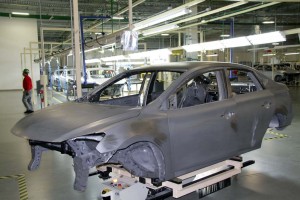
A new Sentra on the Nissan assembly plant in Aguascalientes, Mexico. Emerging markets are expected to drive the auto sales boom.
There will soon be a billion cars, trucks and crossovers on the world’s roads, but that number could more than double as demand continues to escalate in emerging markets, especially the so-called BRIC countries, according to a new report.
A total of 83 million new vehicles will have been sold by the end of this year, according to a study by Charles Chesbrough, a senior economist with IHS Automotive, a 3% gain over 2012. But by 2018, the annual production rate is expected to reach a record 100 million, he predicts, and that is likely far from the peak.
Pointing to the BRIC countries – Brazil, Russia, India and China – as well as other fast-growing economies such as Indonesia, Chesbrough said, “We’re seeing rising wealth that’s creating new customers for the auto industry.”
Indeed, China is already the world’s largest automotive market and despite a recent slowdown is expected to continue growing at a pace well in excess of the U.S., the industry’s long-time leader. Much of that growth has occurred in a narrow band along the Pacific Rim where China’s economy has shown the fastest gains. But that growth in wealth is now starting to spread to other parts of the country.
(“Last frontier” markets could soon be a major force in global auto market. Click Here for details.)
If the average income in the BRICs and other emerging markets were to just reach the level of South Korea, noted Chesbrough, “We’re talking about (a potential demand for) 1 billion more vehicles.”
Emerging markets are clearly driving the auto industry’s growth. From the year 2000 to 2020, the BRIC nations alone are expected to see an 805% increase in automotive sales, according to the IHS study, with other emerging markets growing by 157%. By comparison, so-called mature markets will actually experience a 6% decline in demand.
(GM approaching record sales in China. Click Here for more.)
The good news, said economist Chesbrough, is that after one of the worst downturns since the Great Depression, sales are starting to revive in those older markets. The U.S. will end 2013 with sales in excess of 15.5 million vehicles, the strongest numbers in six years, and a big reversal of fortunes since demand dipped below 10 million during the depths of the downturn. IHS expects sales to reach at least 16 million in 2014, but it is uncertain whether the American rebound will see the auto industry beat its previous peak of a decade ago.
In Europe, meanwhile, Chesbrough noted that the economy is showing signs of having bottomed out, with car sales on the mend. In fact, the European carmaker’s association reported a 1.2% year-over-year increase in registrations for November, the third consecutive monthly gain.
(As Mexican auto production booms, Nissan fires up major new plant. Click Herefor the full story.)
A variety of factors could, of course, impact just how much the overall demand for automobiles grows worldwide. While Chesbrough said the American House of Representatives took a positive step forward with a House-passed budget bill, it still remains to be seen if it will be approved by the Senate, and there is still the threat of a fiscal default if a new debt limit measure isn’t approved – something that could shake the global economy.
Fuel prices are another concern, though IHS forecasts that prices will, if anything, dip slightly for a few more years, reflecting recent increases in production in the Mideast, North and South America.
If anything, a strong global economy could see car sales top 110 million annually by 2020, while rising income levels could fuel the growth of the worldwide fleet to well over 2 billion.
